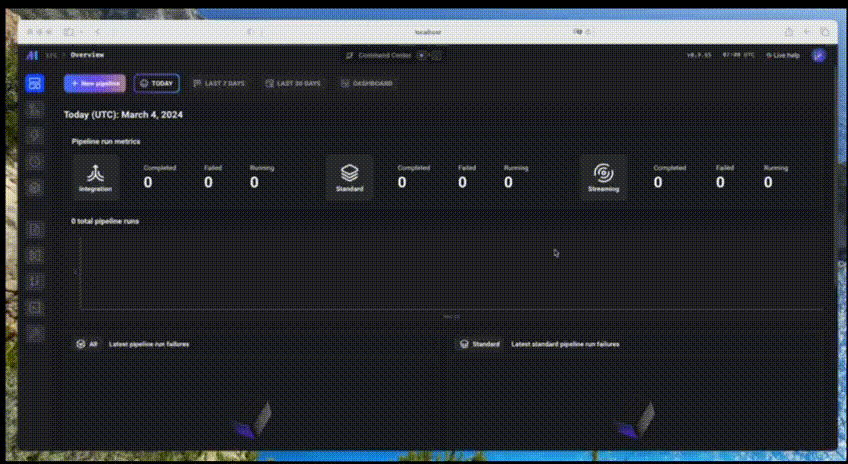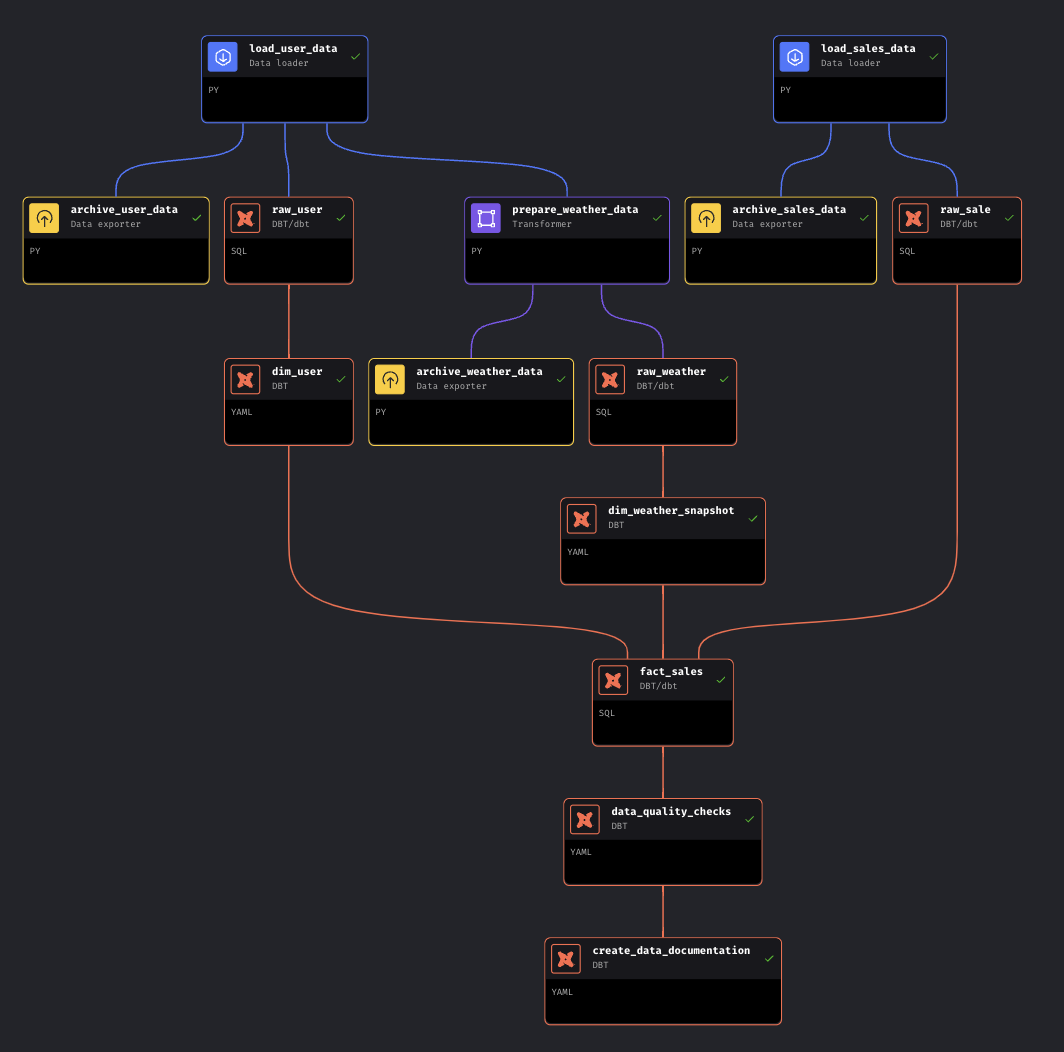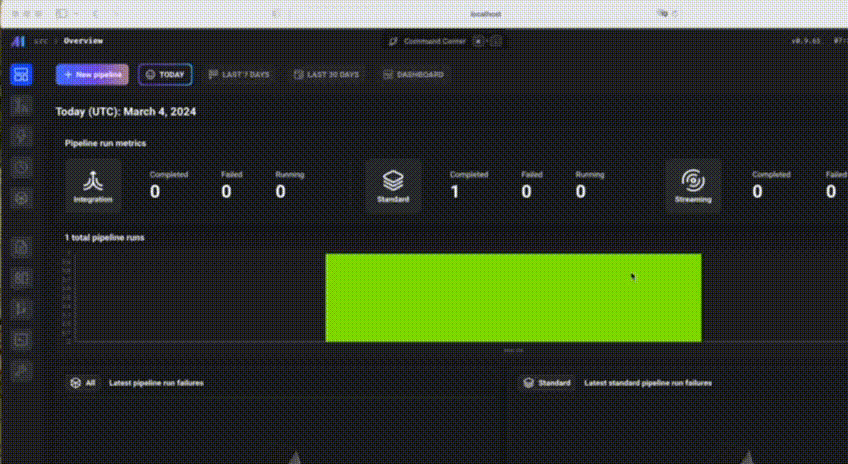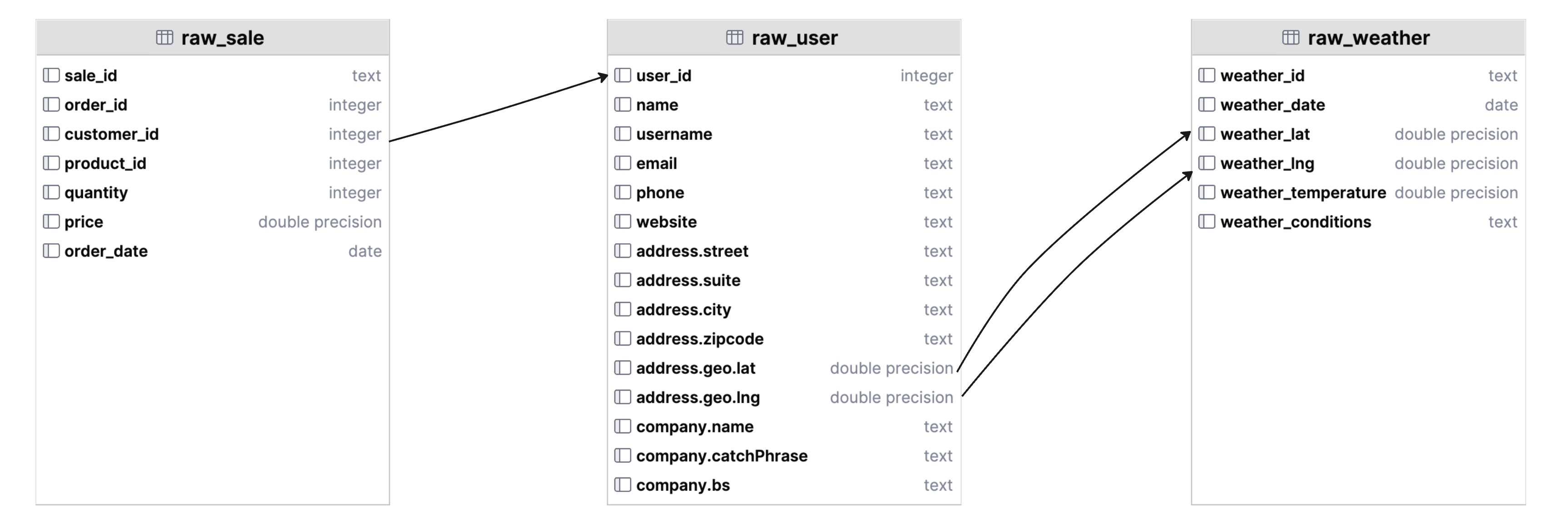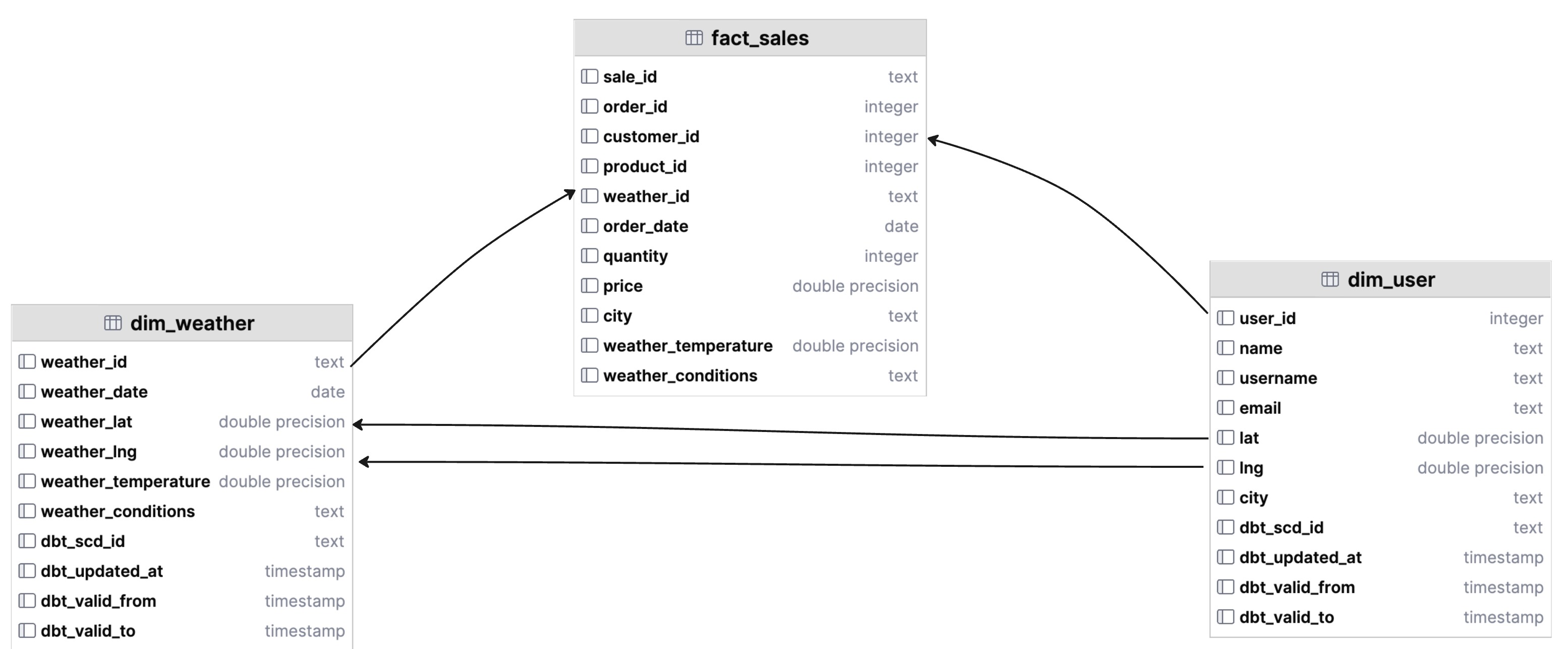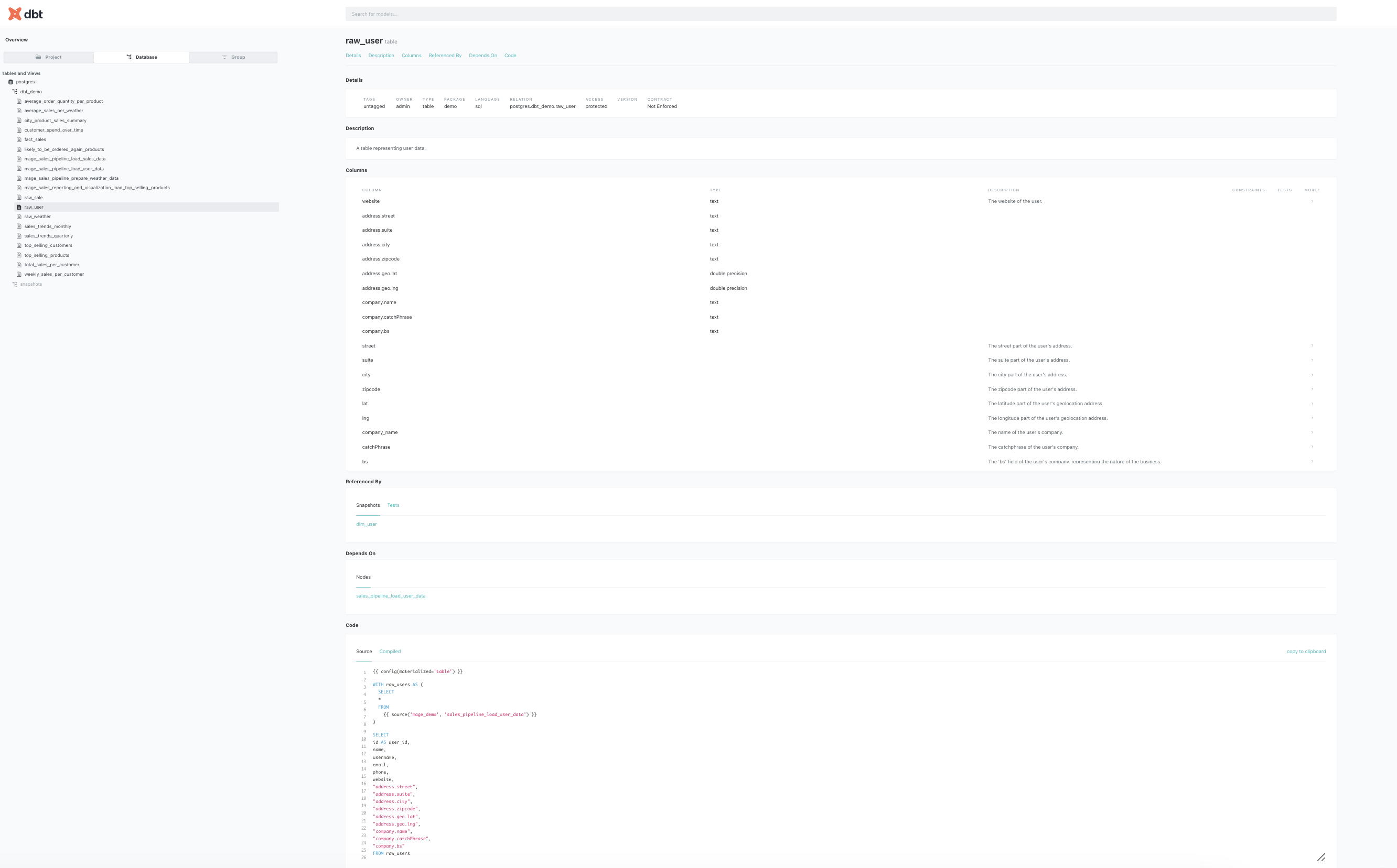This project involves constructing an advanced sales data pipeline for a retail company, integrating sales data with user and weather information to facilitate comprehensive analysis of customer behavior and sales trends.
- Python: For scripting and automation of the pipeline.
- MageAI: For pipeline orchestration, visualization and integrate and synchronize data from various sources.
- DBT (Data Build Tool): For transforming data with SQL.
- PostgreSQL: As the relational database management system.
-
To run the pipeline, follow these steps:
-
Clone the repository:
git clone https://github.com/7AM7/sales-elt -
Navigate to the project directory:
cd sales-elt -
Create a
.envfile in the project root directory with the following environment variables:POSTGRES_DB=postgres POSTGRES_USER=admin POSTGRES_PASSWORD=admin PG_HOST_PORT=5432 POSTGRES_HOST=postgres-magic POSTGRES_SCHEMA=dbt_demo WEATHER_API_KEY={WEATHER_API_KEY}NOTE: To obtain your unique
WEATHER_API_KEY, sign up or log in at OpenWeatherMap and follow their instructions. -
Start the services using Docker:
docker-compose up
After running the Docker command, you will have access to the following:
- MageAI: http://localhost:6789/ - A web interface for managing, visualizing and transforming data.
- DBT Documentation: http://localhost:8001/ - Provides an overview of your DBT models, their lineage, and documentation.
Note: You may need to refresh the page for DBT docs to load properly.
-
-
-
How to run the pipeline
-
The following diagram represents the ELT pipeline implemented in this project:
Above image depicts the workflow of the ELT (Extract, Load, Transform) pipeline. It illustrates the processes from data extracting to loading and final transformation.
-
Data Extracting:
- Parallel extracting of sales (Local File) and user data (User API).
- Retrieve weather information based on the user's geographical coordinates (latitude and longitude) through the specified weather data API endpoint.
- Store the extracted data in the
archive/users,archive/sales, andarchive/weatherdirectories, naming the files according to the pipeline execution timestamp in the formatyear-month-day-hour.csv.
-
Data Loading:
- Load the data into three tables:
raw_user,raw_weather, andraw_sale. - Initiate preliminary transformations by defining unique identifiers for sales and weather records to ensure data uniformity and integrity prior to the detailed transformation phase.
- Load the data into three tables:
-
Transformation:
- Data from
raw_useris transformed and stored intodim_userwith snapshot scehma to keep the user history. - Data from
raw_weatheris similarly transformed intodim_weather. - The transformation process include data cleaning and manipulation.
fact_salesis an incremental table created by joiningdim_useranddim_weather. Only includes active records to reflect the most recent data and using the fact for reporting and visualizations.
- Data from
-
How to run the pipeline
To run the sales reporting and visualization pipeline, adhere to the following steps within the Sales Pipeline interface:
- From the menu located in the left corner, select Pipelines.
- Identify and click on the
sales_reporting_and_visualizationpipeline. - Initiate the pipeline by pressing Run@once and then confirm with Run now.
- To observe the execution details and review logs, click on the recently generated run instance.
-
How to check the Dashboard
-
The Sales Reporting and Visualizations Pipeline is a sophisticated segment of our data system that utilizes DBT for executing a variety of aggregation queries on the
fact_salestable. The purpose of this pipeline is to derive actionable business insights and facilitate data-driven decision-making. Below is a table detailing the business questions addressed, the visualizations used to present the data, and the insights or impacts derived from each analysis.
-
In our data pipeline, we employ a star schema for organizing our data warehouse, which is particularly conducive to the Extract, Load, Transform (ELT) process. This approach begins with the extraction of data from various sources, which is then stored in raw tables designed to hold the unprocessed data. The raw tables in our schema include raw_sale, raw_user, and raw_weather, which capture the essential attributes required for sales transactions, user profiles, and weather conditions respectively.
The star schema comes into play during the transformation step, where the raw data is processed and organized into dimension (dim_) and fact (fact_) tables. The dimension tables, dim_user and dim_weather, contain attributes that describe the entities involved in the sales process, while the fact_sales table captures the quantitative metrics of each sale, like quantity and price, as well as the keys linking to the dimension tables.
The star schema is favored in data warehousing for its simple structure that centralizes fact tables with surrounding dimension tables, enhancing OLAP query efficiency and simplifying BI and analytics processes. Our use of the star schema ensures ease of complex query execution and adaptability for future growth.
Below are the database schema diagrams that outline the structure of our raw and transformed tables:
This diagram illustrates the raw tables including raw_sale, raw_user, and raw_weather.
This diagram shows the transformed star schema structure with dim_user, dim_weather, and fact_sales tables.
Ensuring high data quality is paramount in our ELT pipeline to maintain the integrity of reports and analytics. To achieve this, we leverage dbt tests to systematically validate our data against several common data issues. Within dbt, there are four out-of-the-box tests that are particularly useful for maintaining data quality:
not_null: This test is used to ensure that specified columns do not contain any null values, which is crucial for fields that are expected to have data in every record.unique: This test checks for uniqueness in a column’s values, preventing duplicate entries that could skew data analysis and reporting.accepted_values: While we do not use this test in our current pipeline, it's worth mentioning that it allows for the specification of a set of acceptable values for a column, ensuring data conforms to expected criteria.relationships: This test verifies referential integrity by ensuring that a column in one table correctly references corresponding values in another table.
For our specific data quality needs in the sales_pipeline, we implement the not_null, unique, and relationships tests. These tests are essential for ensuring the following:
- All sales, user, and weather records have complete information.
- Each record is distinct and identifiable, maintaining the uniqueness of data points like sale ID or user ID.
- There is referential integrity between our fact and dimension tables, which is crucial for the star schema to function correctly in joining data for analytics.
The execution of these tests can be triggered through dbt tests commands or by using the data quality checks block within the sales_pipeline. By consistently applying these tests, we uphold the reliability and trustworthiness of our data, thereby empowering data-driven decision-making with confidence.
These dbt tests are part of our automated data validation procedures that run as part of the pipeline's workflow. This proactive approach to data quality helps prevent the propagation of errors and ensures that any issues are identified and resolved promptly, maintaining the overall health of our data ecosystem.
Our data management strategy incorporates a systematic approach to versioning and archiving. This ensures we maintain a comprehensive historical record of our datasets, which is crucial for retrospective analysis, auditing, and data recovery.
For each dataset, including users, weather, and sales data, we generate timestamped files following a consistent naming convention that incorporates the date and time of the data snapshot. These files are then stored in a structured repository, organized into dedicated subfolders for each data category.
The archiving process is automated, with each new pipeline execution creating a directory—if it does not already exist—and saving the current data extract as a CSV file. This file is named using the pattern YYYY-MM-DD-HH.csv, representing the year, month, day, and hour of the data loaded.
The benefits of this archiving process are multifold:
- Historical Integrity: By having a timestamped record of data, we can trace the evolution of our datasets and understand the historical context of our analytics.
- Audit Trail: The versioned files serve as an audit trail for all changes, fulfilling compliance and governance requirements.
- Data Recovery: In case of data loss or corruption, we can revert to a previous version of the data, ensuring business continuity.
We use dbt docs generate to create an accessible documentation site that details our data models, enhancing understanding and navigation for the sales_pipeline. This interactive documentation allows for model searches, SQL code reviews, and insight into data structure through visual lineage charts. The process, which can be executed within our pipeline, results in transparent, collaborative, and well-governed data operations.
To generate this documentation, you can execute the dbt docs generate command or run the create dbt documentation process within the sales_pipeline.
Here is an example of what the dbt documentation looks like, providing a clear, organized view of our data models:
The pipeline we've architected is highly scalable and adaptable, laying a solid groundwork for detailed sales and customer behavior analytics. Harnessing the power of MageAI for pipeline orchestration, visualization, and data integration from diverse sources, combined with DBT for SQL-based data transformation, has proven to be a formidable duo in accomplishing this project's objectives. This synergy enhances our data pipeline's capability, facilitating powerful and comprehensive analytics.

